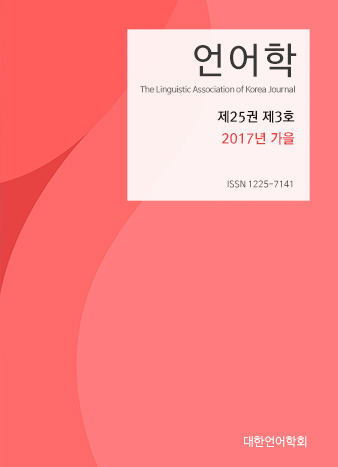대한언어학회 전자저널

25권 3호 (2017년 9월)
- 영어 수업 컨설팅 관점에 관한 연구: 코퍼스 분석을 중심으로
-
김나유 & 이희철
Pages : 93-112
Abstract
Kim, Nayu & Lee, Heechul. (2017). The viewpoint of consulting English class based on corpus analysis. The Linguistic Association of Korea Journal, 25(3), 93-112. The aim of this study was to research English class consultants points of view by analyzing corpus data from cases of English classes. To investigate it, this study conducted quantitative research by analyzing corpus data from 103 reports (30,953 tokens, 8,922 types) written by consultants who had monitored English classes, and qualitative one by reviewing thirteen cases from each report. This research found that the consultants focused more on students behavior and activity than teachers one, and paid more attention to the aim of the class rather than students learning strategies on process of whole class. Moreover, the consultants placed much value on students learning motivation, and gave students confidence and will of participating in class much weight. In addition, time management was regarded as a significant component in organizing class by the consultants. On the dimension of four skills activities, the consultants presented specific improvement of reading instruction, but introduced vague and abstract direction of speaking and writing instruction to the teachers. The findings of this research imply that the viewpoint of consulting class needs more to include teachers behavior, students strategies, flexibility of time management and specific ways to innovate speaking and writing instruction.
Keywords
# 제 2언어 습득(second language acquisition) # 영어 수업 컨설팅(English teaching consultation) # 코퍼스 분석(corpus analysis) # 사례연구(case study)
References
- 권덕원. (2007). 음악 교과 수업 컨설팅 연구. 학교 컨설팅과 수업컨설팅의 과제와 전망. 경인교육대학교 산학협력단․서울대학교 학교 컨설팅 연구회 공동 세미나 자료집.
- 김인옥. (2013). 그룹기반 수업 컨설팅이 초등예비교사의 영어 수업 역량에 미치는 영향. 영어교육, 68(2), 131-151.
- 김종훈. (2012). 영어 수업 컨설팅에 대한 영어교사의 인식 고찰. 영어영문학, 17(3), 203-231.
- 김혜련, 박약우. (2010). 초등 예비교사 영어수업 컨설팅 적용 연구. 초등영어교육, 16(1), 31-63.
- 김혜련, 부경순. (2007). 초등영어 수업컨설팅 적용 연구. 초등영어교육, 13(2), 33-64.
- 설규주. (2007). 사회과 수업 컨설팅 모형 개발. 학교 컨설팅과 수업컨설팅의 과제와 전망. 경인교육대학교 산학협력단․서울대학교 학교 컨설팅 연구회 공동 세미나 자료집.
- 이상수, 강정찬, 이유나, 오영범. (2015). 체계적 수업 분석을 위한 수업 컨설팅. 서울: 학지사, 115-132.
- 이상수, 이유나, 리리. (2008). 좋은 수업에 대한 한․중 고등학교 교사의 학생의 인식비교 연구. 비교교육연구, 18(3), 27-47.
- 이용숙. (2007). 수업컨설팅의 방향. 열린교육실행연구, 10. 3-30.
- 이화진, 오상철, 홍선주. (2006). 수업컨설팅 지원 및 활성화 방안-문제점, 프로그램 지원, 정책 제언을 중심으로. 열린교육실행연구, 10. 33-63.
- 장경숙, 민병수, 최보윤. (2013). 초․중등 영어 교과 수업컨설팅에 대한 인식 연구. 외국어교육, 20(4), 315-341.
- 장경숙, 한은미. (2007). 멘토링을 통한 초임교사 영어수업능력 신장: 스토리텔링을 중심으로. 초등영어교육, 13(2), 65-96.
- 진동섭, 홍창남, 김도기. (2011). 학교경영컨설팅과 수업컨설팅. 경기: 교육과학사, 87-102.
- Andersen, P. A. (1999). Nonverbal communication: Forms and functions. Mountain View, CA: Mayfield Publishing.
- Borich, G. D. (2011). Observation skills for effective teaching (6th ed.). Boston, MA: Allyn & Bacon.
- Dick, W., Carey, L., & Carey, J. O. (2009). The Systematic Design of Instruction (7th ed.). New Jersey: Pearson Education.
- Hills, S. B., Naegle, N., & Bartkus, K. (2009). How important are items on a student evaluation? A study of item salience. Journal of Education for Business, 84(5), 297-303.
- Keller, J. M. (2006). Motivation and performance. Trends and Issues in Instructional Design and Technology, 2, 82-92.
- Kim, Jee Won., & Rhee, Seok-Chae. (2014). A corpus-based study on Korean EFL learners’ use of resultive conjunctive adverbials. The Linguistic Association of Korea Journal, 22(4), 143-161.
- Seiler, W. J., & Beall, M, L. (2005). Communication: Making connections (7th ed.). Boston, MA: Pearson Education.
- Shim, Jaewoo., Lee, Heechul., & Jin, Seunghee. (2016). A study on the relationship between self-efficacy belief and beliefs and comprehension in English reading. The Linguistic Association of Korea Journal, 24(4), 129-149.